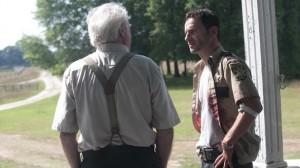
For the first time in its run, The Walking Dead seems to know what it’s doing. I sat back and breathed a sigh of relief when new characters and locations were introduced gradually over the past two episodes. Finally, the sense that we’re going somewhere (Sorry that it took you getting shot to set the show’s gears in motion, Carl). We’ve been given a lot of plot so far: Carl is shot and recovering at a Southern Gothic farmhouse, Shane and one of the farm guys went on a run to grab medical supplies that ended in a shocking and gruesome twist, Sophie the little girl is still missing, etc. It runs against typical TV logic, but I think that the more dangling plot threads and unanswered questions that exist in The Walking Dead, the better.
A show that’s primary theme is survival should have a sense of desperate, inexorable forward momentum; when the characters’ RV stalls out on a deserted highway, so does the show. The Walking Dead obviously isn’t a sitcom (heavy de-emphasis on the “com”), but I would describe it as a sit-drama. Most cable dramas have episodic themes (i.e., in Mad Men, they deal with a Japanese company for one episode and WWII vet Roger Sterling has to deal with the world moving by without him, etc.), but The Walking Dead lives and dies with actual physical and perilous situations that entangle the characters. So far in its run, when this show isn’t white knuckle, it’s no-knuckle. There are very little existential or philosophical questions being posed here, besides “How do I best avoid being eaten by reanimated corpses?” In short, the characters can be a drag.
Much like a real apocalyptic survival situation (I would imagine), the danger of post-apocalyptic entertainment is that viewers can become stranded with intensely unlikeable characters and not really have a choice in the matter. The world has ended, and this is who we’re stuck with? Great. Thankfully, The Walking Dead has taken steps this season to remedy this and make some of the characters either more likeable or just less paper-thin. (Lori is the notable exception. She joins the AMC pantheon of shrewish and annoying women leads, a trend that surely isn’t intentional but still stands out as off-putting. Though Lori still has no chance of ripping away the title from perennial bitch-dynasty Betty Draper.)
The character of T-Dog, once the show’s vague nod toward the fact that a group of post-apocalyptic survivors in Atlanta, Georgia would mathematically have to have a black guy in it, has started to round out nicely. He even got super-meta in the second episode and acknowledged that he’s the token black guy in the group. But to the show’s credit, he’s still alive nine episodes in to the show’s run, breaking one of horror’s most time-honored tropes. (RIP, Samuel L. Jackson in Jurassic Park. You taught a nation how to “hold on to their butts” and for that you were unceremoniously sent out alone into a park full of loose dinosaurs.)
T-Dog’s progress as a three-dimensional character is encouraging, but then there’s Andrea. She still aggressively wants to kill herself, Dale still wants to aggressively prevent that, and the viewer is still aggressively apathetic about the whole situation. Sorry, Andrea. Don’t care. But any lateral moves or back-steps those supporting characters take have been authoritatively cancelled out by Shane.
Shane is the most compelling character on the show, mostly because he’s been given the most to do. He banged Rick’s wife when Rick was sleeping off the zombie apocalypse, but he’s been shown in flashbacks desperately trying to save Rick’s life in the hospital. He wants nothing more than to ditch the group and head off on his own, but he’s the first to hurl himself into peril to get medical supplies from a local school to save Carl’s life. And then there’s the twist at the end of “Save the Last One,” and it was a doozy. When Shane and Otis (the guy that shot Carl in the first place and one of the farmhouse residents) are fleeing a zombie horde, Shane shoots Carl in the leg and leaves him for dead. He withholds this information from the group. Between injuring and leaving a man for dead and bumping uglies with Rick’s wife, Shane is racking up secrets left and right, secrets that could destroy their already-fragile group dynamic.
Extra Notes
- These were also the first episodes to take full advantage of the show’s atmospheric Georgia setting; the bucolic farmhouse where Carl recovers is downright Faulknerian. Part of what makes The Walking Dead mythology so special is that it is set in the Deep South. It’s an atmosphere that already comes preloaded with density and dread, and the show would be wise to use it more often.
- If you’re new to reading my TV coverage, I really dislike doing episode-by-episode recaps of shows. I try to avoid recapping the minutiae of the plot, especially for a show like The Walking Dead that doesn’t exactly deal with heavy thematic issues, and instead discuss more the trends of the show and character development and so on. I think it’s a good assumption that you’ve seen the episodes, right?
